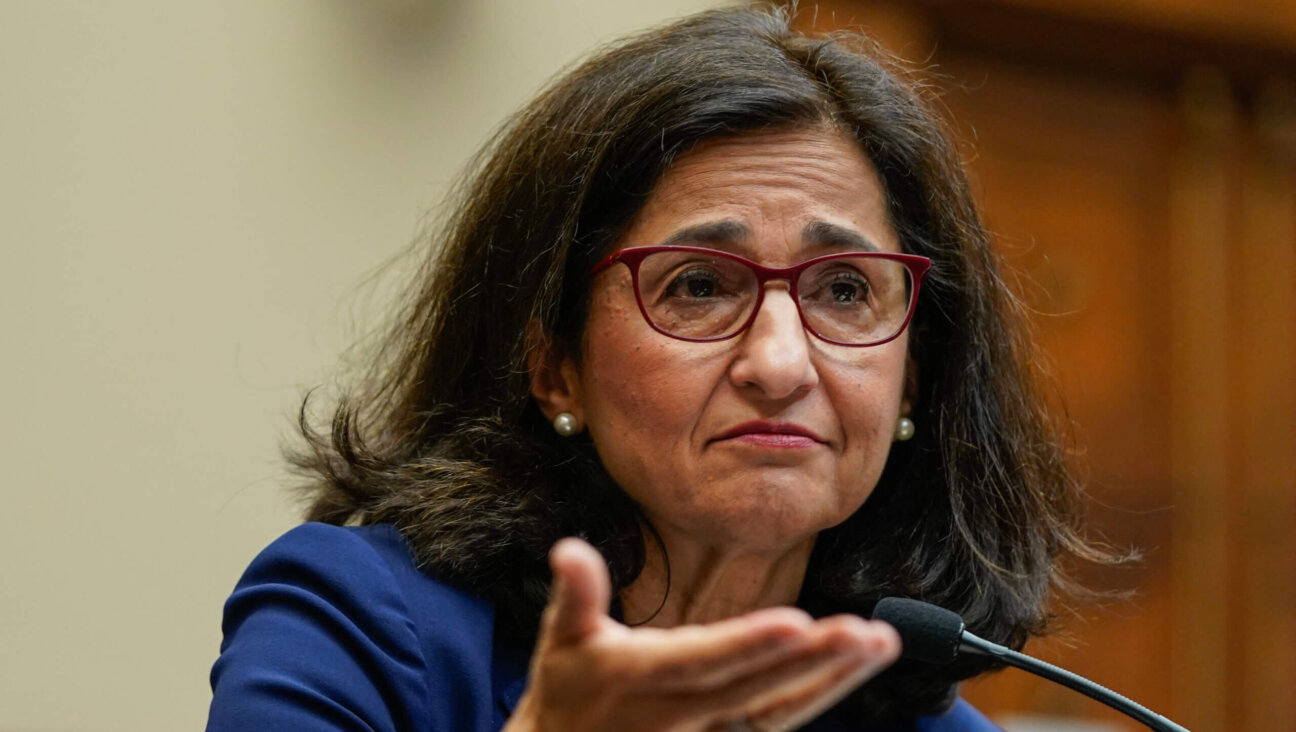What do Jews of color really think — and who are they anyway?

Jewish women of color were front and center at the National Women’s March in Washington, D.C. on January 2019. Image by Candace Bond
Why is this study different from other studies? Read the Forward’s story on this groundbreaking report.
If you’re looking for a guide to the perplexities of “Beyond the Count: Perspectives and Lived Experiences of Jews of Color,” a good start might be not to think of it as one single study.
It’s really two, and they might have been better titled as “Who exactly are Jews of Color anyway?” and “So what do Jews of color think?”
The work, or both of them, was commissioned by the Jews of Color Initiative, and involved a slew of impressive academics who tabulated the responses of 1,118 participants identified as Jews of color.
It began with describing the term.
“‘Jews of Color’ is understood as an imperfect, but useful umbrella term that encompasses a wide range of identities and meanings,” the narrative reads.
“Those who self-identified as JoC in this study used the term in a multiplicity of ways: as a racial grouping (e.g. Black, Asian, and multiracial Jews); to indicate national heritage (e.g. Egyptian, Iranian, and Ethiopian Jews); to describe regional and geographic connections (e.g. Latina/o/x, Mizrahi, Sephardic Jews); and to specify sub-categories (e.g. transracially adopted Jews and Jewish Women of Color).”
Then there are those who, while clearly falling into one or more of the above categories, may not themselves identify as “of color,” even if the majority of people who encounter them have no problem assuming what they are. Race, as everyone from Rachel Dolezal to the self-described “Cablasian” Tiger Woods can tell you, is as much defined by how others see you as how you perceive yourself.
After defining its terms, the report offers a wealth of demographic information about the Jews of color it studied — with the caveat that it was not based on a weighted sample to project the total size and makeup of the community, but a voluntary survey circulated mainly among engaged Jews of color. While it is just a snapshot of those respondents, it is the largest and most detailed such snapshot ever produced. Some highlights are:
- 21% identified as Black, African or African American
- 11% as Hispanic or Latino/a/x
- 10% as Asian American
- 7% as Middle Eastern or North African
-
1% as Native American, First Nation or Indigenous American
-
42% reported having one Jewish parent, 22% two Jewish parents and 33% no Jewish parents
-
49% were raised Jewish, 16% raised Jewish and something else, 36% not Jewish
-
77% reported their current religious tradition as Jewish exclusively, 21% as Jewish and another religion
-
67% of respondents identified as women, 23% as men, 9% as non-binary, or another gender
That last category certainly seems to underscore what I said earlier about the study not representing Jewish population of color as a whole; it would make our communities vastly more female-dominated than the general population.
Then again, the overwhelming majority of children adopted from China were girls until recently, according to a Pew study, which would likely skew the gender spread of Jewish adoptive families.
And I should probably check my own progeny before questioning other people’s math: I have one daughter; she has two children — a boy and a girl. While statistically beyond insignificant, it matches the sampling precisely: Two-thirds of my descendants are female Jews of color.
If the study’s analysis of who we are is food for thought, its account of what we think is a banquet:
-
80% of respondents said they have experienced discrimination in Jewish settings, most in synagogues or other spiritual communities. One in five said they had not experienced discrimination in Jewish settings.
-
Most “agreed they have had a wide range of negative experiences in Jewish communal settings,” as the survey put it, with 75% stating “others have made assumptions about me based on my skin tone.”
-
“Respondents do not feel that American Jewish leaders are adequately addressing racism and white supremacy within the American Jewish community,” the study reports; 65% said the leaders are addressing the needs of Jews of color poorly or very poorly.
If that’s a dire picture, it’s not exactly news. Jews of color have been pointing out those failings for years, in numerous accounts in the Jewish media and beyond. There are countless examples of worshippers being asked if they’re Jewish, or assumed to be the help, or, in a favorite experience of my own at a suburban Twin Cities synagogue, being mistaken for Rod Carew (my batting average never quite matched his, I’m afraid).
But it isn’t all j’accuse or woe is me. More than half “agreed they have felt a sense of belonging among white Jews,” the report reads, “and 41% agree they have been able to find opportunities to express all sides of themselves in predominantly white Jewish spaces.” Three quarters of the respondents described working for justice and equality — Tikkun Olam — as the most important expression of Jewish identity.
Jews of all colors might want to consider that, and the inherent responsibilities it demands. It begins by understanding who each of us is, made a little clearer with a study like this one.
Or, as I said, both of these.
The Forward is free to read, but it isn’t free to produce

I hope you appreciated this article. Before you go, I’d like to ask you to please support the Forward.
Now more than ever, American Jews need independent news they can trust, with reporting driven by truth, not ideology. We serve you, not any ideological agenda.
At a time when other newsrooms are closing or cutting back, the Forward has removed its paywall and invested additional resources to report on the ground from Israel and around the U.S. on the impact of the war, rising antisemitism and polarized discourse.
This is a great time to support independent Jewish journalism you rely on. Make a gift today!
— Rachel Fishman Feddersen, Publisher and CEO
Support our mission to tell the Jewish story fully and fairly.
Most Popular
- 1

Culture Cardinals are Catholic, not Jewish — so why do they all wear yarmulkes?
- 2

Fast Forward Ye debuts ‘Heil Hitler’ music video that includes a sample of a Hitler speech
- 3

News School Israel trip turns ‘terrifying’ for LA students attacked by Israeli teens
- 4

Fast Forward Student suspended for ‘F— the Jews’ video defends himself on antisemitic podcast
In Case You Missed It
-

Yiddish קאָנצערט לכּבֿוד דעם ייִדישן שרײַבער און רעדאַקטאָר באָריס סאַנדלערConcert honoring Yiddish writer and editor Boris Sandler
דער בעל־שׂימחה האָט יאָרן לאַנג געדינט ווי דער רעדאַקטאָר פֿונעם ייִדישן פֿאָרווערטס.
-

Fast Forward Trump’s new pick for surgeon general blames the Nazis for pesticides on our food
-

Fast Forward Jewish feud over Trump escalates with open letter in The New York Times
-

Fast Forward First American pope, Leo XIV, studied under a leader in Jewish-Catholic relations
-
Shop the Forward Store
100% of profits support our journalism
Republish This Story
Please read before republishing
We’re happy to make this story available to republish for free, unless it originated with JTA, Haaretz or another publication (as indicated on the article) and as long as you follow our guidelines.
You must comply with the following:
- Credit the Forward
- Retain our pixel
- Preserve our canonical link in Google search
- Add a noindex tag in Google search
See our full guidelines for more information, and this guide for detail about canonical URLs.
To republish, copy the HTML by clicking on the yellow button to the right; it includes our tracking pixel, all paragraph styles and hyperlinks, the author byline and credit to the Forward. It does not include images; to avoid copyright violations, you must add them manually, following our guidelines. Please email us at [email protected], subject line “republish,” with any questions or to let us know what stories you’re picking up.
















